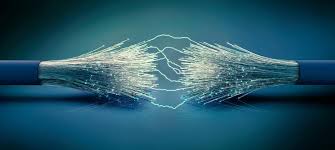The Workings Of Fiber Optic Internet
The upcoming future of the broadband is fiber optic internet. In the recent days it utilizes the technology of fiber optic for reaching the fastest speeds which is as fast as ten thousand Mbps. Having a broadband became compulsory to the present modern world that we are living in. This internet is siding away the rivals from its place. Fiber optic internet is a form of fiber optic communications. When you send a light beam through the glass cables of fiber optic, you can be capable to transport the data through it which is actually a process that is fascinating.
How Fiber Optic Internet Operates
The cables of fiber are made up of little optical fibers. These fibers made seems to be thin and are less than a tenth as a human hair thickness. Although they are thin, they might have many things going on inside them. Every optical fiber consists of two parts one is core other is cladding.
- The core is actually made with glass and it is the fiber innermost part where the light usually through it.
- Another one is cladding which is plastic or glass with thicker layer. It is wrapped around the core.

These both of the parts work as one for making a phenomenon known as total internal reflection. This total internal reflection is the way how the light is capable to move through the fibers without escaping from them. This happens when the light hits the glass at shallow angle which is lower than forty-two degrees and reflects back again like the reflection that happens against a mirror. The part cladding keeps the light inside the core as the plastic or glass is created with a different lower refractive index or optical density. Two of these terms clearly shows how the part of the glass bends and slows down the passing light.
The light is transmitted down to the fiber in LED or Laser pulses which travel in a fast way. These created pulses carry the data which is binary, this is the system of coding we find on the internet. The code of binary is created of bits which are just zeroes or ones. These code bits send the message in the eight-part patterns which are organized known as bytes. It is simple to translate this binary code bits into the pulses of light. One pulse means it is one and no pulse means it is zero. These optic pulses of light can travel for about sixty miles even before they experience any kind of degradation. For transporting the information across miles of thousands these light pulses go through the optical amplifiers that keeps boosting their signal such that no information is lost or stolen.
Once the light pulses reach their destination, an optical network terminal will convert these pulses into Ethernet which is electrical. This is the way how light is going to turn into something you can utilize for connecting your devices to the internet. This kind of conversion only occurs at the last mile end which is not at all a mile but known as a term for the fiber last stretch which connects you to the Internet backbone.
The internet backbone is what it makes it possible for the individual around the globe for connecting through the web. This is mostly created of fiber optic cables. This fiber optic internet might seem to the customers like a brand type of new technology. Yet it is around many internet early days in the world. These fiber optic cables were present under the ocean for connecting it the Europe and US in the year 1988. These were the first lines of submarine to be laid and at present they are extended in a crisscross way in the entirety of the floor of the ocean.
The core of the internet is the backbone. The minute you connect to a site no matter the destination or the device, several steps are being taken to bring you at that point and each one of them is connected through the backbone of the internet.